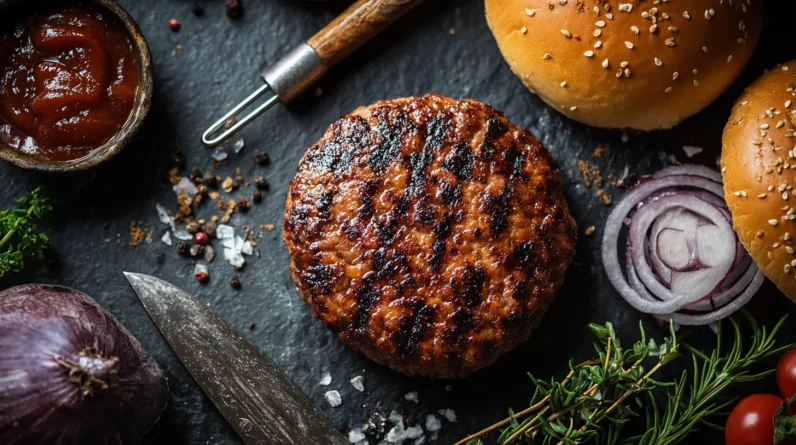
A truly healthy burger starts with grass-fed, grass-finished beef that contains 2-4 times more omega-3s than grain-fed alternatives. We should choose minimally processed ground beef, avoid high-temperature cooking that creates cancer-linked compounds, and skip commercial additives like nitrates and “pink slime.” Swapping refined buns for lettuce wraps or sprouted grains, plus adding nutrient-dense toppings like avocado, transforms your burger from nutritional disaster to health-conscious meal when we recognize the complete picture.
The Quality of Your Beef: Grass-Fed vs. Grain-Fed Cattle
The foundation of any healthy beef burger starts with the cattle’s diet and living conditions. We’ll examine how cattle feed directly impacts the nutritional profile of our beef. Grass-fed cattle consume their natural diet of pasture grasses, producing meat with higher omega-3 fatty acids, conjugated linoleic acid (CLA), and antioxidants like vitamin E. Grain-fed cattle receive corn and soy-based diets, resulting in higher omega-6 fatty acids and saturated fat content. Research demonstrates grass-fed beef contains 2-4 times more omega-3s than grain-fed alternatives. When selecting beef, we must navigate confusing beef labeling terms. “Grass-finished” guarantees cattle ate grass throughout their lives, while “grass-fed” may include grain finishing. Understanding these distinctions helps us make informed choices for maximum burger nutrition.
Processing Methods That Make or Break Nutritional Value
Beyond selecting quality beef, how we process and prepare our ground meat substantially affects its nutritional density and safety profile. Commercial meat processing often involves mechanical separation techniques that introduce oxygen, accelerating lipid oxidation and degrading omega-3 fatty acids. We’ll preserve more nutrients by choosing minimally processed ground beef or grinding whole cuts ourselves.
Proper handling procedures prevent bacterial contamination while maintaining nutritional integrity. Temperature control during processing proves critical—exposure to heat above 40°F promotes pathogen growth and nutrient degradation. We should select ground beef processed under strict cold-chain protocols and avoid products with extended shelf exposure.
Additionally, grinding incorporates air pockets that increase surface area, making the meat more susceptible to oxidative damage. Fresh-ground options minimize this exposure, preserving both flavor compounds and heat-sensitive vitamins.
Cooking Techniques and Their Impact on Health
Once we’ve secured high-quality, minimally processed ground beef, our cooking method becomes the determining factor in preserving—or destroying—its nutritional value. Grill temperature and meat handling directly influence the formation of harmful compounds while affecting nutrient retention.
| Cooking Method | Temperature Range | Health Impact |
|---|---|---|
| Grilling (High Heat) | 400-500°F | Forms HCAs and PAHs |
| Pan-Searing | 300-350°F | Moderate compound formation |
| Sous Vide | 130-140°F | Minimal nutrient loss |
| Steaming | 212°F | Preserves water-soluble vitamins |
High-temperature cooking creates heterocyclic amines (HCAs) and polycyclic aromatic hydrocarbons (PAHs)—compounds linked to cancer risk. We can minimize these by marinating beef beforehand, avoiding charring, and maintaining moderate temperatures. Proper meat handling includes avoiding cross-contamination and achieving safe internal temperatures of 160°F without excessive heat exposure.
Additives, Preservatives, and Hidden Ingredients to Avoid
Commercial ground beef often contains a cocktail of additives that can undermine our health goals, even when we’ve chosen quality meat and proper cooking methods. We’ll find sodium nitrates, sulfites, and artificial preservatives lurking in processed varieties, which can trigger inflammatory responses and disrupt cellular function. Food labels reveal troubling ingredients like carrageenan, modified food starch, and flavor enhancers that mask inferior meat quality.
Cross contamination presents another concern when facilities process multiple protein sources without adequate separation protocols. We’re also encountering “pink slime” – ammonia-treated lean finely textured beef – in conventional ground meat products. Phosphate additives artificially enhance water retention, creating misleading texture while adding unnecessary sodium. Reading ingredient lists becomes vital for identifying these hidden compounds that compromise our burger’s nutritional integrity.
The Bun and Toppings: How Sides Can Sabotage Your Burger
The healthiest beef patty can quickly transform into a nutritional nightmare when we pile on refined buns, processed cheese, and sugar-laden condiments. Traditional white buns contribute empty calories, spike blood glucose, and lack essential nutrients. We’re better served choosing bun alternatives like portobello mushroom caps, lettuce wraps, or sprouted grain options that provide fiber and micronutrients without inflammatory refined carbohydrates.
Smart topping suggestions include avocado for healthy monounsaturated fats, fresh tomatoes for lycopene, and leafy greens for folate and antioxidants. Skip the processed cheese and bacon—opt for organic cheese or nutritional yeast instead. Ditch sugary ketchup and mayo for mustard, hummus, or homemade sauces using olive oil and herbs. These strategic choices preserve our burger’s nutritional integrity.
Portion Control and Frequency: Finding the Right Balance
Even quality beef burgers require mindful portion sizing to maintain their place in a healthy diet. We must consider both serving size and consumption frequency when incorporating burgers into our meal planning strategy.
| Frequency | Recommended Portion |
|---|---|
| Weekly (1-2x) | 4-6 oz patty |
| Bi-weekly | 6-8 oz patty |
| Monthly | 8+ oz patty |
| Special occasions | Variable portions |
Research demonstrates that mindful eating practices substantially impact satiety and nutritional outcomes. When we consume 4-6 ounce portions weekly, we can accommodate burgers within recommended saturated fat limits while maintaining protein targets. This approach allows us to enjoy quality beef while supporting long-term health goals. Strategic timing around physical activity enhances nutrient utilization and metabolic benefits.
Conclusion
We’ve decoded the burger’s nutritional matrix—from pasture to plate. Choosing grass-fed beef, minimal processing, and proper cooking temperatures isn’t rocket science, but it’s certainly more complex than our ancestors faced when hunting mammoth. Skip the processed buns loaded with refined sugars, pile on antioxidant-rich vegetables, and practice moderation. The evidence shows we can transform this American staple into a nutrient-dense meal that supports our health goals rather than sabotaging them.







